小学五年级英语语法练习(全)
- 格式:doc
- 大小:138.00 KB
- 文档页数:18
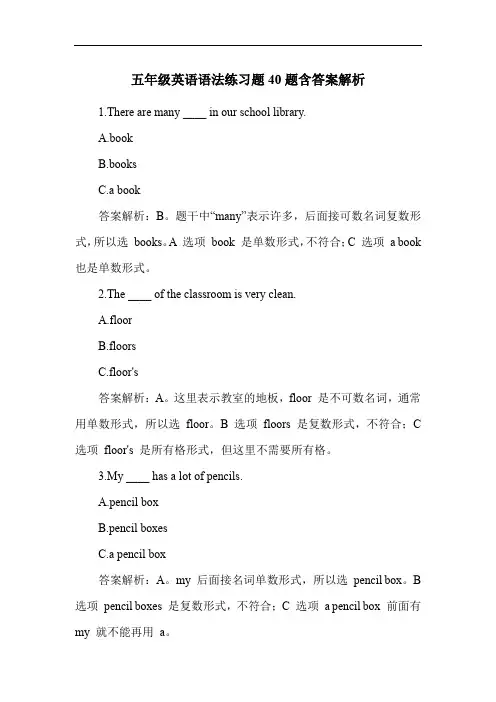
五年级英语语法练习题40题含答案解析1.There are many ____ in our school library.A.bookB.booksC.a book答案解析:B。
题干中“many”表示许多,后面接可数名词复数形式,所以选books。
A 选项book 是单数形式,不符合;C 选项a book 也是单数形式。
2.The ____ of the classroom is very clean.A.floorB.floorsC.floor's答案解析:A。
这里表示教室的地板,floor 是不可数名词,通常用单数形式,所以选floor。
B 选项floors 是复数形式,不符合;C 选项floor's 是所有格形式,但这里不需要所有格。
3.My ____ has a lot of pencils.A.pencil boxB.pencil boxesC.a pencil box答案解析:A。
my 后面接名词单数形式,所以选pencil box。
B 选项pencil boxes 是复数形式,不符合;C 选项a pencil box 前面有my 就不能再用a。
4.The ____ names are on the blackboard.A.studentB.studentsC.students'答案解析:C。
这里表示学生们的名字,要用名词所有格形式students'。
A 选项student 是单数形式,不符合;B 选项students 是复数形式,但不是所有格。
5.There are some ____ on the desk.A.appleB.applesC.an apple答案解析:B。
some 后面接可数名词复数形式,所以选apples。
A 选项apple 是单数形式,不符合;C 选项an apple 也是单数形式。
6.The ____ teacher is very kind.A.womenB.womanC.women's答案解析:B。
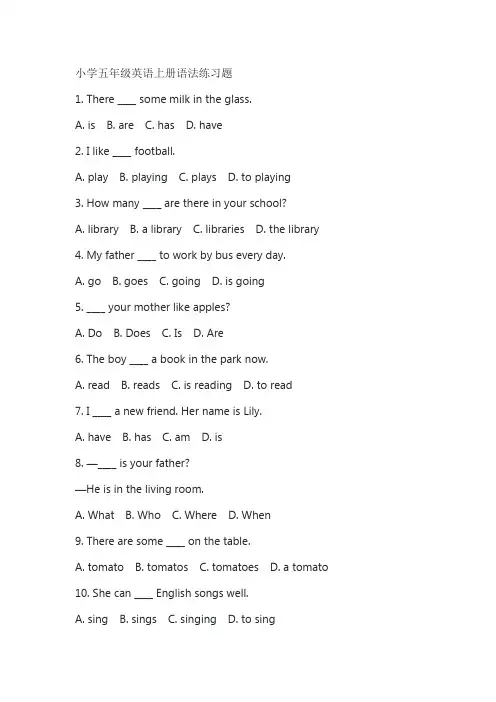
小学五年级英语上册语法练习题1. There ____ some milk in the glass.A. isB. areC. hasD. have2. I like ____ football.A. playB. playingC. playsD. to playing3. How many ____ are there in your school?A. libraryB. a libraryC. librariesD. the library4. My father ____ to work by bus every day.A. goB. goesC. goingD. is going5. ____ your mother like apples?A. DoB. DoesC. IsD. Are6. The boy ____ a book in the park now.A. readB. readsC. is readingD. to read7. I ____ a new friend. Her name is Lily.A. haveB. hasC. amD. is8. —____ is your father?—He is in the living room.A. WhatB. WhoC. WhereD. When9. There are some ____ on the table.A. tomatoB. tomatosC. tomatoesD. a tomato10. She can ____ English songs well.A. singB. singsC. singingD. to sing11. Look! The cat ____ after the mouse.A. runB. runsC. is runningD. are running12. We usually ____ TV on Saturday evenings.A. watchB. watchesC. watchingD. to watch13. —____ do you have PE lessons?—Twice a week.A. How manyB. How muchC. How oftenD. How long14. There ____ a lot of water in the bottle.A. isB. areC. hasD. have15. My sister ____ her homework every day.A. doB. doesC. doingD. is doing16. I want ____ a postcard for my friend.A. buyB. to buyC. buyingD. buys17. ____ you have a good time last Sunday?A. DoB. DoesC. DidD. Are18. The children ____ in the park now.A. playB. playsC. are playingD. is playing19. How much ____ the toy car?A. isB. areC. doesD. do20. There are ____ months in a year.A. twelveB. twelfthC. the twelveD. the twelfth21. I'm ____ than my brother.A. strongB. strongerC. strongestD. the strongest22. My birthday is ____ May 1st.A. inB. onC. atD. to23. She ____ a good time at the party last night.A. haveB. hasC. hadD. is having24. —____ is that dress?—It's 50 yuan.A. How manyB. How muchC. How oldD. How long25. He ____ up at 7:00 every morning.A. getB. getsC. gettingD. is getting26. There ____ a lot of people at the concert last night.A. wasB. wereC. isD. are27. I like reading books ____ the weekend.A. inB. onC. atD. for28. She is ____ than me.A. tallB. tallerC. tallestD. the tallest29. We ____ a party for my mother's birthday yesterday.A. haveB. hasC. hadD. are having30. —____ do you do on Sundays?—I often play football.A. WhatB. WhoC. WhereD. When31. The boy is ____ to his mother.A. talkB. talksC. talkingD. to talk32. I ____ some pictures in the park last Sunday.A. takeB. takesC. tookD. am taking33. There are three ____ in my family.A. peopleB. peoplesC. a peopleD. the people34. My father is ____ than my mother.A. oldB. olderC. oldestD. the oldest35. —____ are you?—I'm fine, thank you.A. WhatB. WhoC. WhereD. How36. She ____ a lot of friends at school.A. haveB. hasC. hadD. is having37. I often go ____ with my parents on Sundays.A. shopB. shopsC. shoppingD. to shopping38. The book is ____ interesting.A. a littleB. littleC. a fewD. few39. There ____ a football match next Sunday.A. isB. areC. will beD. will have40. He can speak English very ____.A. goodB. wellC. niceD. great41. I ____ my grandparents last weekend.A. visitB. visitsC. visitedD. am visiting42. The girl ____ red is my sister.A. inB. onC. atD. to43. How many ____ do you have?A. hobbyB. hobbiesC. a hobbyD. the hobby44. My brother ____ TV every evening.A. watchB. watchesC. watchingD. is watching45. There ____ some bread and milk on the table.A. isB. areC. hasD. have46. I'm going to ____ a film tomorrow.A. seeB. seesC. seeingD. to see47. She ____ to bed at 9:00 every night.A. goB. goesC. goingD. is going48. The boy is ____ his homework carefully.A. doB. doesC. doingD. to do49. There are two ____ in the city.A. zooB. zoosC. a zooD. the zoo50. I ____ a lot of fun at the party last night.A. haveB. hasC. hadD. am having答案1. A2. B3. C4. B5. B6. C7. A8. C9. C 10. A11. C 12. A 13. C 14. A 15. B 16. B 17. C 18. C 19. A 20. A21. B 22. B 23. C 24. B 25. B 26. B 27. C 28. B 29. C 30. A 31. C 32. C 33. A 34. B 35. D 36. B 37. C 38. A 39. C 40. B 41. C 42. A 43. B 44. B 45. A 46. A 47. B 48. C 49. B 50. C。
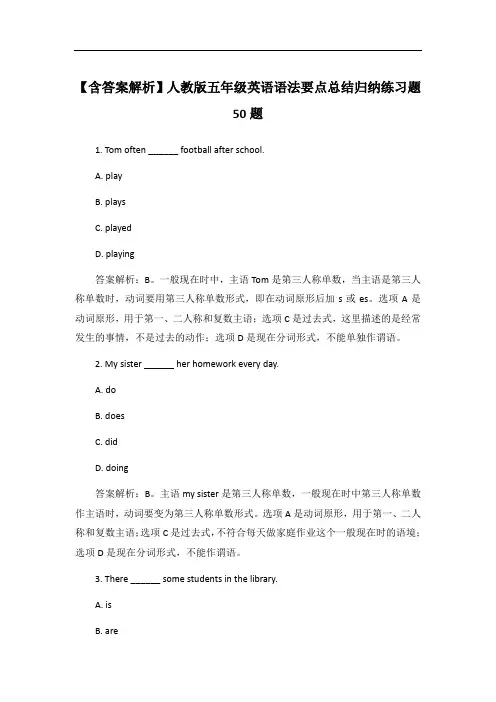
【含答案解析】人教版五年级英语语法要点总结归纳练习题50题1. Tom often ______ football after school.A. playB. playsC. playedD. playing答案解析:B。
一般现在时中,主语Tom是第三人称单数,当主语是第三人称单数时,动词要用第三人称单数形式,即在动词原形后加s或es。
选项A是动词原形,用于第一、二人称和复数主语;选项C是过去式,这里描述的是经常发生的事情,不是过去的动作;选项D是现在分词形式,不能单独作谓语。
2. My sister ______ her homework every day.A. doB. doesC. didD. doing答案解析:B。
主语my sister是第三人称单数,一般现在时中第三人称单数作主语时,动词要变为第三人称单数形式。
选项A是动词原形,用于第一、二人称和复数主语;选项C是过去式,不符合每天做家庭作业这个一般现在时的语境;选项D是现在分词形式,不能作谓语。
3. There ______ some students in the library.A. isB. areC. wasD. were答案解析:B。
本题考查there be句型,be动词的单复数形式取决于后面的名词。
students是复数名词,所以be动词要用复数形式are。
选项A是单数形式,用于后面接单数名词或不可数名词;选项C是is的过去式,这里描述的是现在的情况,不是过去;选项D是are的过去式,不符合语境。
4. He ______ to school by bike.A. goB. goesC. wentD. going答案解析:B。
主语he是第三人称单数,在一般现在时中,第三人称单数作主语时,动词要变为第三人称单数形式。
选项A是动词原形,用于第一、二人称和复数主语;选项C是过去式,这里说的是通常的上学方式,不是过去的动作;选项D是现在分词形式,不能作谓语。
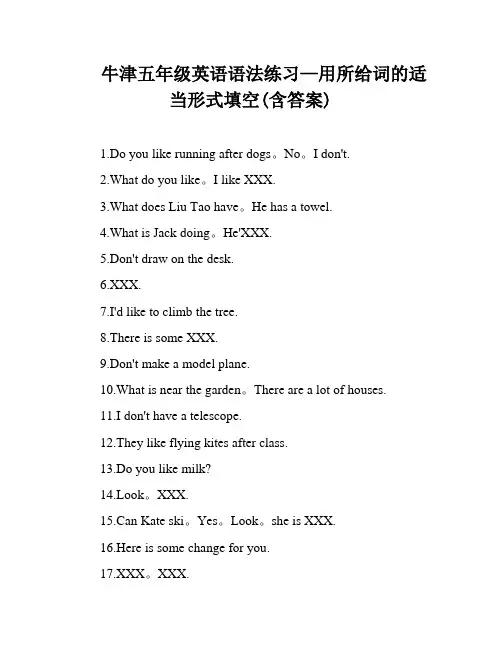
牛津五年级英语语法练习—用所给词的适当形式填空(含答案)1.Do you like running after dogs。
No。
I don't.2.What do you like。
I like XXX.3.What does Liu Tao have。
He has a towel.4.What is Jack doing。
He'XXX.5.Don't draw on the desk.6.XXX.7.I'd like to climb the tree.8.There is some XXX.9.Don't make a model plane.10.What is near the garden。
There are a lot of houses.11.I don't have a telescope.12.They like flying kites after class.13.Do you like milk?14.Look。
XXX.15.Can Kate ski。
Yes。
Look。
she is XXX.16.Here is some change for you.17.XXX。
XXX.18.How many students want to be a doctor?19.XXX。
I am having XXX.20.XXX possess。
He can write in English。
What is he doing now。
He is copying words.21.Please do not read the newspaper。
Read the magazine instead.22.What do the children have。
They have some cards。
What does the woman have。
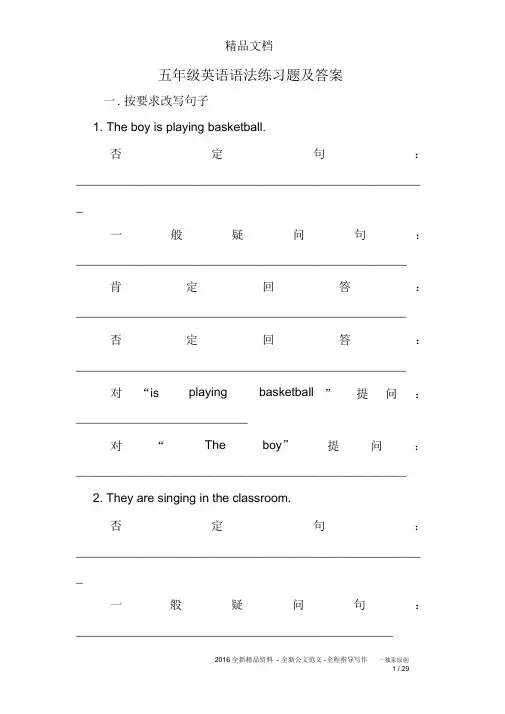
精品文档五年级英语语法练习题及答案一. 按要求改写句子1.The boy is playing basketball.否定句:___________________________________________________ _一般疑问句:_________________________________________________肯定回答:__________________________________________________否定回答:__________________________________________________对“is playing basketball”提问:__________________________对“The boy”提问:__________________________________________________2. They are singing in the classroom.否定句:___________________________________________________ _一般疑问句:_______________________________________________精品文档肯定回答:__________________________________________________否定回答:__________________________________________________对“are singing”提问:__________________________对“in the classroom”提问:__________________________3.仿照例句造句 :Model:read a book --What are you doing?--I ’m reading a book.1).read a new book________________________________________2).clean the blackboard________________________________________4.she,the window,open,now._____________________________________________就划线部分提问)________________________________________________6.is,who,the window,cleaning?精品文档______________________________________________就划线部分提问)________________________________________________8.She is closing the door now.______________________________________________9.You are doing your homework.______________________________________________10.they, the tree, sing, now, under._____________________________________________11.The Young Pioneers are helping the old woman.______________________________________________ II.单项选择1.我在照看孩子 .I am looking after the baby.I ’m look aftering the baby.I look am aftering the baby.I looking after the baby.2._____friend’s making______a kite.I,meMy,my My,me His,his3.Is the woman ______ yellow your teacher?in putting on wearing having精品文档4.Look!The twins_____theirmother do the housework.are wanting helpare helpingare looking5._____are the birds doing? They are singing ina tree.6.Is she____something?eateatingeattingeats7.你在干什么 ?What is you doing? What are you do?What are you doing?What do you do?8.What are you listening_____?/ for at to9.我正在听他说话 .I listening to him. I’m listening to him.I ’m listen to him. I’m listening him.10.They are_____their clothes.makeing puttingput away putting on11.Listen! She____in the classroom.is singing sing to sing is sing12.Today Jim______ his white shirt and brown trousers.is putting onwear put onis wearing13.______are you eating?I’m eating______meat.What,some Which,anyWhere,notWhat,a14.They______TV in the evening.They do their homework.are watching can’t watching don’t watch don’t watching15.The children_____football.is playing are playingplay the play a16.They are flying kites.他们喜欢放风筝.他们在放风筝吗?他们在放风筝 .他们常放风筝.17.Here are many books. Please_____them.look write counttaking18.Look,They are swimming in the river.I want_____you.to go with go with helping19.The man_____mear the house now.20.Look.Lucy is_____a new bike today.jumpingrunning ridingIII.用现在进行时完成下列句子 :1.What_________you__________?2.I_____________ an English song.3.What________he____________?4.He______________ a car.5.______you__________ a kite?Yes,_______.6.______she___________ in the boat?7.______you_____________ questions?8.We_______________ games now.help takeingHow many months are there in a year ?一年有多少个月?There are twelve .可简答: Twelve . What ’ s the first month of the year ?有十二个月。
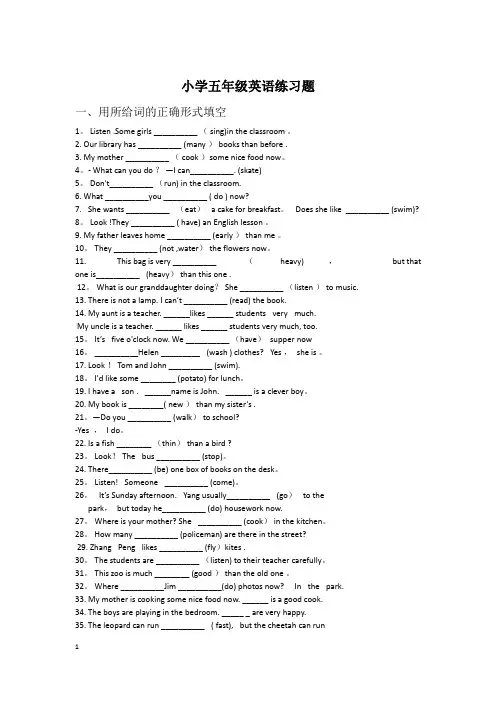
小学五年级英语练习题一、用所给词的正确形式填空1。
Listen.Some girls__________(sing)in the classroom。
2.Our library has__________(many)books than before.3.My mother__________(cook)some nice food now。
4。
- What can you do?—I can__________.(skate)5。
Don't__________(run)in the classroom.6.What__________you__________(do)now?7.She wants__________(eat) a cake for breakfast。
Does she like__________(swim)? 8。
Look!They__________(have)an English lesson。
9.My father leaves home__________(early)than me。
10。
They__________(not,water)the flowers now。
11.This bag is very__________ (heavy),but that one is__________(heavy)than this one.12。
What is our granddaughter doing?She__________(listen)to music.13.There is not a lamp.I can’t__________(read)the book.14.My aunt is a teacher.______likes ______ students very much.My uncle is a teacher.______ likes ______ students very much, too.15。
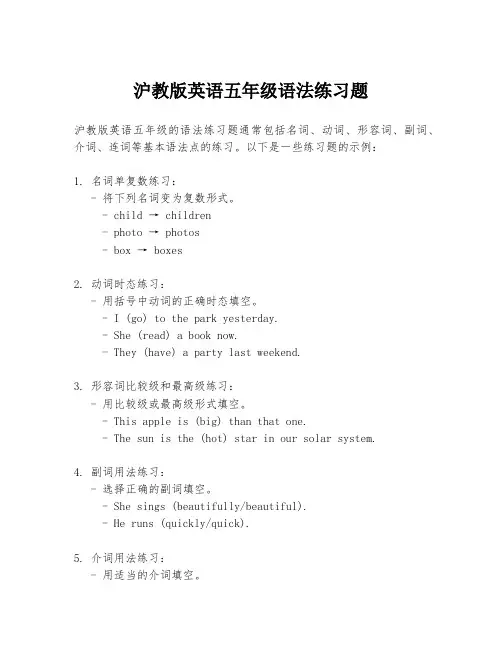
沪教版英语五年级语法练习题沪教版英语五年级的语法练习题通常包括名词、动词、形容词、副词、介词、连词等基本语法点的练习。
以下是一些练习题的示例:1. 名词单复数练习:- 将下列名词变为复数形式。
- child → children- photo → photos- box → boxes2. 动词时态练习:- 用括号中动词的正确时态填空。
- I (go) to the park yesterday.- She (read) a book now.- They (have) a party last weekend.3. 形容词比较级和最高级练习:- 用比较级或最高级形式填空。
- This apple is (big) than that one.- The sun is the (hot) star in our solar system.4. 副词用法练习:- 选择正确的副词填空。
- She sings (beautifully/beautiful).- He runs (quickly/quick).5. 介词用法练习:- 用适当的介词填空。
- The cat is (under/on) the table.- We go to school (by/with) bus.6. 连词用法练习:- 用适当的连词填空。
- I will go to the park (if/because) it doesn't rain.- He can play the piano, (and/but) he prefers the guitar.7. 疑问句练习:- 将下列陈述句变为一般疑问句,并给出肯定和否定回答。
- She is a teacher.- Is she a teacher? Yes, she is. No, she isn't.8. 否定句练习:- 将下列句子变为否定句。
- They have some apples.- They don't have any apples.9. 特殊疑问句练习:- 用疑问词填空。
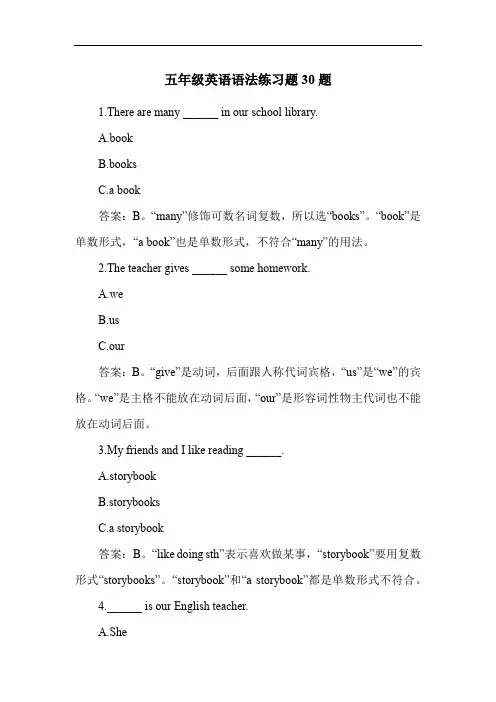
五年级英语语法练习题30题1.There are many ______ in our school library.A.bookB.booksC.a book答案:B。
“many”修饰可数名词复数,所以选“books”。
“book”是单数形式,“a book”也是单数形式,不符合“many”的用法。
2.The teacher gives ______ some homework.A.weC.our答案:B。
“give”是动词,后面跟人称代词宾格,“us”是“we”的宾格。
“we”是主格不能放在动词后面,“our”是形容词性物主代词也不能放在动词后面。
3.My friends and I like reading ______.A.storybookB.storybooksC.a storybook答案:B。
“like doing sth”表示喜欢做某事,“storybook”要用复数形式“storybooks”。
“storybook”和“a storybook”都是单数形式不符合。
4.______ is our English teacher.A.SheB.HerC.Hers答案:A。
“is”前面要用主格,“she”是主格。
“her”是形容词性物主代词或宾格,“hers”是名词性物主代词,都不符合。
5.We can see many ______ on the playground.A.childB.childrenC.a child答案:B。
“many”修饰可数名词复数,“children”是“child”的复数形式。
“child”和“a child”都是单数形式不符合。
6.______ book is on the desk?A.Who'sB.WhoseC.Who答案:B。
“Whose”表示“谁的”,后面跟名词。
“Who's”是“Who is”的缩写,不符合题意。
“Who”是“谁”,不能直接跟名词。
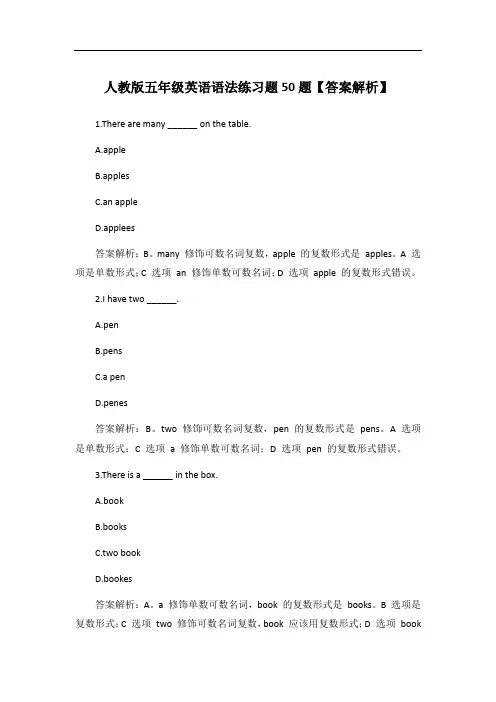
人教版五年级英语语法练习题50题【答案解析】1.There are many ______ on the table.A.appleB.applesC.an appleD.applees答案解析:B。
many 修饰可数名词复数,apple 的复数形式是apples。
A 选项是单数形式;C 选项an 修饰单数可数名词;D 选项apple 的复数形式错误。
2.I have two ______.A.penB.pensC.a penD.penes答案解析:B。
two 修饰可数名词复数,pen 的复数形式是pens。
A 选项是单数形式;C 选项 a 修饰单数可数名词;D 选项pen 的复数形式错误。
3.There is a ______ in the box.A.bookB.booksC.two bookD.bookes答案解析:A。
a 修饰单数可数名词,book 的复数形式是books。
B 选项是复数形式;C 选项two 修饰可数名词复数,book 应该用复数形式;D 选项book的复数形式错误。
4.She has three ______.A.pencilB.pencilsC.a pencilD.penciles答案解析:B。
three 修饰可数名词复数,pencil 的复数形式是pencils。
A 选项是单数形式;C 选项 a 修饰单数可数名词;D 选项pencil 的复数形式错误。
5.There are some ______ in the bag.A.rulerB.rulersC.a rulerD.ruleres答案解析:B。
some 修饰可数名词复数或不可数名词,ruler 的复数形式是rulers。
A 选项是单数形式;C 选项a 修饰单数可数名词;D 选项ruler 的复数形式错误。
6.I see four ______.A.dogB.dogsC.a dogD.doges答案解析:B。
four 修饰可数名词复数,dog 的复数形式是dogs。
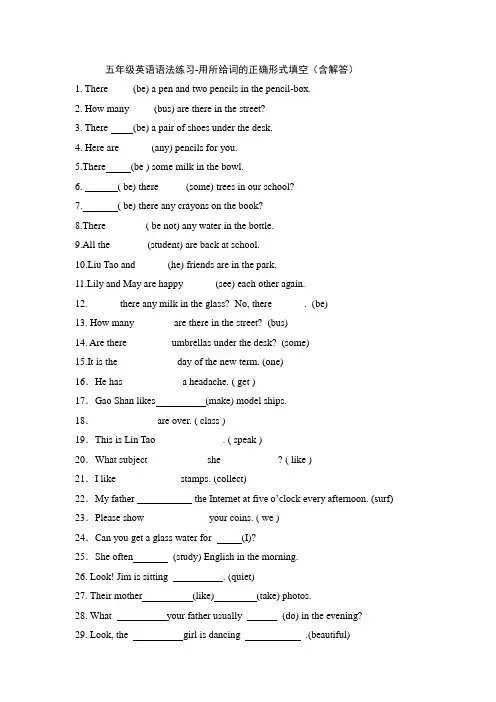
五年级英语语法练习-用所给词的正确形式填空(含解答) 1. There ____ (be) a pen and two pencils in the pencil-box. 2. How many ____ (bus) are there in the street? 3. There (be) a pair of shoes under the desk. 4. Here are ______(any) pencils for you. 5.There (be ) some milk in the bowl. 6. ( be) there _____(some) trees in our school? 7. ( be) there any crayons on the book? 8.There _______ ( be not) any water in the bottle. 9.All the _______(student) are back at school. 10.Liu Tao and ______(he) friends are in the park. 11.Lily and May are happy ______(see) each other again. 12. ______there any milk in the glass? No, there ______. (be) 13. How many _______ are there in the street? (bus) 14. Are there ________ umbrellas under the desk? (some) 15.It is the ___________ day of the new term. (one) 16.He has ___________ a headache. ( get ) 17.Gao Shan likes (make) model ships. 18.____________ are over. ( class ) 19.This is Lin Tao _____________. ( speak ) 20.What subject ___________ she ___________? ( like ) 21.I like ____________ stamps. (collect) 22.My father ___________ the Internet at five o’clock every afternoon. (surf) 23.Please show ____________ your coins. ( we ) 24.Can you get a glass water for (I)? 25.She often (study) English in the morning. 26. Look! Jim is sitting . (quiet) 27. Their mother (like) (take) photos. 28. What your father usually (do) in the evening? 29. Look, the girl is dancing .(beautiful) 30. (not ) stand in a line! 31. Everybody (have) two arms and two legs. 32. What Mike (do) ? He is putting an egg on his head. 33. Mary usually to the park on foot. (go) 34. I’m on duty today. I (need) clean the windows. 35. My mother (not do) housework in the morning . 36.Who ______ (want) ______ (play) basketball with us? 37. Children’s Day is _____(come), Mum would like _______(buy)things for me. 38. He is a _________ (good)student. He studies very __________(good). 39.You____(be) late. Don’t ___ (be ) late again 40. It’s time _______ (have) lunch. Let’s _______ (go) now. 41. I ________ (get ) up at 6:30 every day, but my sister _________ (get ) up at 7:40. 42. Who _____ (be) on duty today? Lucy and Lily ________ (be). 43. I usually _________ (have) my breakfast at 7:00. But now I _________(have)my breakfast. 44. The _________(child) near the library are all from ________ (Chinese). 45. Can he _______ (touch) his toes with his fingers? No, he ________. 46. Ben’s hobby is ______________ (grow) flowers. 47. He can _____________ (make) model planes. 48. I make pretty ____________ (dress) for my dolls. 49. He is showing _____________ (they) to his classmates. 50. My mother is _____________ (water) the flowers in the garden now. 51、The sister ( not collect) insects in the garden now. isn’t collecting 52. the students ( have) a good time? 53. It is __ __ (one) lesson of the new term. 54. My father can _______ (ride) a horse.
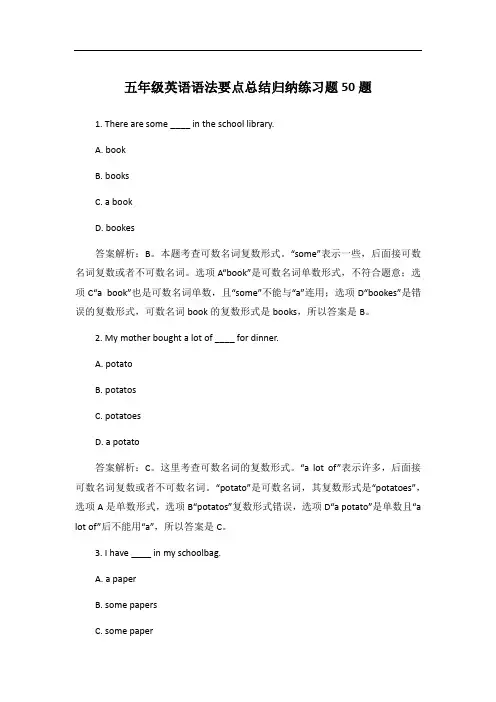
五年级英语语法要点总结归纳练习题50题1. There are some ____ in the school library.A. bookB. booksC. a bookD. bookes答案解析:B。
本题考查可数名词复数形式。
“some”表示一些,后面接可数名词复数或者不可数名词。
选项A“book”是可数名词单数形式,不符合题意;选项C“a book”也是可数名词单数,且“some”不能与“a”连用;选项D“bookes”是错误的复数形式,可数名词book的复数形式是books,所以答案是B。
2. My mother bought a lot of ____ for dinner.A. potatoB. potatosC. potatoesD. a potato答案解析:C。
这里考查可数名词的复数形式。
“a lot of”表示许多,后面接可数名词复数或者不可数名词。
“potato”是可数名词,其复数形式是“potatoes”,选项A是单数形式,选项B“potatos”复数形式错误,选项D“a potato”是单数且“a lot of”后不能用“a”,所以答案是C。
3. I have ____ in my schoolbag.A. a paperB. some papersC. some paper答案解析:C。
“paper”作为“纸张”讲时是不可数名词,没有复数形式“paperes”,选项D错误;选项A“a paper”用法错误,因为不可数名词不能用“a”修饰;选项B“some papers”错误,“paper”表示“试卷、论文”时是可数名词,这里表示“纸张”,所以用“some paper”,答案是C。
4. There is ____ milk in the glass.A. manyB. a fewC. a littleD. few答案解析:C。
本题考查不可数名词的修饰词。
“milk”是不可数名词。
外研版五年级英语语法练习对于五年级的学生来说,掌握好英语语法是提高英语水平的重要一环。
外研版五年级英语教材中涵盖了众多重要的语法知识点,通过有针对性的练习,可以帮助同学们更好地理解和运用这些语法。
一、名词的单复数名词分为可数名词和不可数名词。
可数名词在表示数量大于一时,要使用复数形式。
例如:book(书)的复数是 books;apple(苹果)的复数是 apples。
但也有一些特殊的变化,如 child(孩子)的复数是children;man(男人)的复数是 men 等。
练习:1、 There are many ______ (flower) in the park2、 How many ______ (classroom) are there in your school?二、一般现在时一般现在时表示经常发生的动作或存在的状态。
当主语是第三人称单数(he,she,it 或单数名词)时,动词要发生变化。
例如:I play football every day 但 He plays football every day 动词 play 变成了 plays。
练习:1、 My father ______ (work) hard every day2、 She ______ (like) reading books三、现在进行时现在进行时表示正在进行的动作,结构是“be +动词的现在分词”。
例如:I am reading a book 动词 read 变成了 reading。
练习:1、 Look! The girls ______ (dance) in the classroom2、 What are you ______ (do) now?四、形容词的比较级和最高级形容词用于描述事物的特征。
比较级用于两者之间的比较,最高级用于三者或三者以上的比较。
例如:tall(高的),其比较级是 taller,最高级是 tallest。
五年级英语语法选择练习题30题(带答案)1. There is ______ "s" in the word "school".A. aB. anC. the答案解析:B。
本题考查冠词的用法。
字母“s”的发音是[es],是以元音音素开头的,所以要用“an”,“a”用于以辅音音素开头的单词前,“the”表示特指,这里不是特指,所以选B。
2. My ______ are teachers.A. parentB. parentsC. parent's答案解析:B。
本题考查名词复数。
根据后面的“are”可知主语是复数,“parent”是单数,“parents”是复数形式,“parent's”是名词所有格形式,所以选B。
3. This is ______ book. It's ______.A. Tom; hisB. Tom's; hisC. Tom; him答案解析:B。
第一空考查名词所有格,“Tom's”表示“汤姆的”,用来修饰“book”;第二空考查名词性物主代词,“his”在这里相当于“his book”,“him”是宾格,所以选B。
4. There are some ______ on the table.A. appleB. applesC. an apple答案解析:B。
本题考查名词复数。
“some”表示“一些”,后面接可数名词复数或者不可数名词,“apple”是可数名词,这里要用复数形式“apples”,“an apple”是单数形式,所以选B。
5. ______ mother is a doctor.A. MaryB. Mary'sC. Marys答案解析:B。
本题考查名词所有格。
“Mary's”表示“玛丽的”,用来修饰“mother”,“Mary”是人名,“Marys”这种形式是错误的,所以选B。
语法及练习1 be动词Be 动词的用法:(1) Am--was Is --was Are--were 口诀:我用am, 你用are, is用在他她它,复数全用are。
(2) 肯定和否定句I am (not) from London. He is(not) a teacher. Sheis(not) in the dining room. My hair is(not) long. Her eyes are(not) small.(3) 一般疑问句Are you a Chinese? Yes, I am. No, I amn’t. Are they American? Yes, they are. No, they aren’t. Is the cat fat? Yes, it is. No, it isn’t.用恰当的be动词填空。
1. I ______ a boy. ______ you a boy? No, I _____ not.2. The girl______ Jack's sister.3. The dog _______ tall and fat.4. The man with big eyes _______ a teacher.5. ______ your brother in the classroom?6. Where _____ your mother? She ______ at home.7. How _______ your father?8. Mike and Liu Tao ______ at school.9. Whose dress ______ this?10. Whose socks ______ they?11. That ______ my red skirt.12. Who ______ I?13.The jeans ______ on the desk.14. Here ______ a scarf for you.15. Here ______ some sweaters for you.16. The black gloves ______ for Su Yang.17. This pair of gloves ______ for Yang Ling.18. The two cups of milk _____ for me.19. Some tea ______ in the glass.20. Gao shan's shirt _______ over there.21. My sister's name ______Nancy.22. This ______ not Wang Fang's pencil.23. ______ David and Helen from England?24. There ______ a girl in the room.25. There ______ some apples on the tree.26. _______ there any kites in the classroom?27. _______ there any apple juice in the bottle?28. There _______ some bread on the plate.29. There _______ a boy, two girls, three men and ten women in the park.30. You, he and I ______ from China.语法及练习2 人称代词和物主代词人称代词和物主代词1.人称代词主格和宾格的区别:主格通常位于句中第一个动词之前(有时候位于than 之后),宾格一般位于动词或介词之后。
五年级英语语法要点总结归纳练习题50题1. There are many ____ in our school library.A.bookB.booksC.book's答案:B。
本题考查名词复数。
根据句中的“many”可知,后面要接可数名词复数形式,“book”的复数是“books”,选项A是单数形式,不符合要求;选项C“book's”是所有格形式,在这里表示很多书,不需要用所有格,所以也不正确。
2. This is ____ classroom. ____ is big and clean.A.our; It; ItC.our; He答案:A。
本题考查代词。
第一空后面有名词“classroom”,需要用形容词性物主代词“our”来表示“我们的”;第二空指代前面的“classroom”,要用“it”,因为“classroom”是物不是人,“he”用于指代男性,所以选项C错误,“us”是宾格形式,不能作主语,选项B也错误。
3. ____ are my good friends.A.TheyB.ThemC.Their“they”是主格,可作主语;“them”是宾格,只能作宾语;“their”是形容词性物主代词,后面需要接名词,所以B和C都不符合要求。
4. I can't find my pen. Can I use ____?A.youB.yourC.yours答案:C。
本题考查名词性物主代词。
这里表示“你的笔”,要用名词性物主代词“yours”,“you”是主格或宾格,不能表示“你的东西”;“your”是形容词性物主代词,后面需要接名词,所以A和B都不对。
5. The ____ bags are on the desk.A.studentsB.student'sC.students'答案:C。
本题考查名词所有格。
这里表示“学生们的书包”,“students”是复数形式,其所有格形式是“students'”,选项A只是复数形式,没有所有格的含义;选项B是单数“student”的所有格,不符合题意。
句型与语法专项复习卷时间:60分钟满分:100分题号一二三四五六七八九十总分得分一、把句子和相应的图片连在一起。
(10分)1.We have a Chinese class today. A.2.I do morning exercises every day. B.3.It's October1st. C.4.The pandas are eating bamboo. D.5.Lily is dancing. E.二、为下列句子选择正确的图片。
(10分)()1.In summer,I can go swimming. A. B.()2.Look!He is sleeping in class. A. B.()3.My parents and I go for a walk on Saturdays.A. B.()4.I like to plant flowers in spring. A. B.()5.Keep your desk clean,please. A. B.三、单项选择。
(10分)()1.The singing contest is________June17th.A.inB.onC.at()2.________the students playing basketball?A.areB.IsC.Are()3.She is________Chinese.A.tellingB.talkingC.speaking()4.There are________days in June.A.thirtyB.thirty-oneC.thirtieth()5.Girls can wear________in summer.A.sweaterB.glovesC.shorts()6.________comes after summer.A.WinterB.AutumnC.Spring()7.Are there________tigers?A.someB.aC.any()8.—________do you like autumn?—________I can pick apples.A.Why;But B.When;AndC.Why;Because ()9.The baby bear is ________the tree with its mother.A.climbsB.climbingC.climb()10.Whose books ________?A.is thereB.is itC.are these四、读一读,用所给词的正确形式填空。
形容词/副词 比较级/最高级 综合练习: ( )1. I think science is _ than Japanese. A. much important B. important C. much more important D. more much important ( ) 2 This pencil is___ than that one. A. longest B. long C. longer D. as long ( ) 3 These children are ____ this year than they were last year. A. more tall B. more taller C. very taller D. much taller ( ) 4 It was very hot yesterday, but it is___ today. A. even hotter B. more hotter C. much more hot D. much hot ( )5 Our classroom is____ larger than theirs. A. more B. quite C. very D. much ( ) 6 Maths is more popular than____. A. any other subject B. all the subjects C. any subject D. other subject ( ) 7 China is larger than ____ in Africa A. any other country B. other countries C. the other country J 1%D. any country ( ) 8 Tom is stronger than ___ in his class. A. any other boy B. any boys C. any boy D. other boy ( ) 9 When spring comes, it gets____. A. warm and warm B. colder and colder C. warmer and warmer D. shorter and shorter ( ) 10 By and by, ____ students in our class came to like English. A. more and more B. much and much C. many and many D. less and least ( ) 11 At last he began to cry ___. A. hard and hard B. more hard and more hard C. harder and harder D. less hard and less harder ( ) 12 When spring comes the days get ____ and nights ____. A. short; long B. long; short C. longer; shorter D. shorter; longer ( )13___ I look at the picture, ____ I like it. A. The best; the more B. The more; the less C. The more; less D. More; the more ( )14___ he read the book, ____ he got in it. A. The more; the more interestingB. The less; the more interesting C. The more; the more interested D. More; more interested ( ) 15 Which do you like ___, tea or coffee? A. well B. better C. best D. most ( ) 16 Which do you think tastes ____, the chicken or the fish? A. good B. better C. best D. well ( ) 17 Who jumped____of all? A. far B. farther C. farthest D. the most far ( ) 18Li Lei is___ student in our class .A. tall B. taller C. tallest D. the tallest ( ) 19 The fifth orange is____ of all. Give it to that small child. A. big B. bigger C. the bigger D. the biggest ( )20 Who is---of you three? A. the oldest B. much older C. oldest D. older ( )21 Tom is one of ____ boys in our class. A. tallest B. taller C. the tallest D. the tall ( )22 The tree is ___ in the garden. A. the taller B. the tallest C. taller than of-all D. tall. ( )23 Which is___, Li Lei or Wu Tong? A. strong B. strongest C. stronger D. the strongest ( )24 Which language is____, English, French or Japanese? A. easy B. the most easy C. the easiest D. much more easy ( 25 Which is____interesting, science, maths or English?A. more B. the most C. very D. too ( )26 Which city is____, Beijing, Shanghai or Fuzhou? A. beautiful B. more beautiful C. much more beautiful D. the most beautiful ( )27 Which month is____, June, July or August? A. hot B. hotter C. hottest D. the hottest ( ) 28 I am twelve; Mike is fourteen; Mary is thirteen. So Mike is the ___ of the three. A. old B. older C. oldest D. the oldest ( ) 29 My ____ brother is three years ____ than I. A. elder; elder B. older; oldest C. elder; older D. older; elder ( ) 30 His ____ son often go to see him on Sunday. A. eldest B. older C. the eldest D. the older ( ) 31 He is two years ___ than I. A. elder B. smaller C. younger D. less
人称代词和物主代词 要点归纳: 一.主格 ( I you he she it we you they ) 1. 在句子中可以作主语,放于句首,后接动词。 (1) _______ am a student. (2) _______ comes from China , but ______ comes from American. (3) _______ is my aunt. 二.宾格 ( me you him her it us you them ) 1. 在句子中可以作宾语,用于句尾,动词之后。 (1) The boy in the photo is _______. (2) Let ______ to play football. (3) We often go to visit __________. 2. 在句子中可以作宾语,用于句尾,介词之后。 (1) The pen of ______ is the same with ______. (2) Come with ________. (3) The teacher wants you to return that book of ________. 3. 人称代词作表语时,一般用宾格,特别是在日常会话中。 “Who is knocking at the door? ” “It's ________. ” ----“谁在敲门?” ---“是我。”
三.形容词性物主代词 ( my your his her it our your their ) 1. 形容词性物主代词一般位于名词前,用作定语,限定该名词的意义。 (1) ______ book is over there. (2) I ate all ________ sandwiches yesterday. (3) Tell Tom not to forget _______ book.
四.名词性物主代词 ( mine yours his hers its ours yourrs theirs) 1. 名词性物主代词在句中独立使用,即不后接名词,其句法作用相当于一个名词,即“形容词性物主代词+名词”。 (1) My bag is bigger than ________. =My bag is bigger than ________ _________. (2) _______ is a great country. 我们的国家是一个伟大的国家。(用作主语,一般用于正式文体) (3) I forgot to bring my dictionary. Could I use _______? 我忘了带词典,我可以用一下你的吗?(用作动词的宾语) (4) He wasn’t in my room. He might be in _______. 他(刚才)不在我的房间。他可能在自己的房间。(用作介词的宾语) (5) Whose book is this? — It’s _______. 这是谁的书?——是她的。(用作表语) (6) Jack is a friend of _______. 杰克是我的一个朋友。(用于双重所有格) 2.名词性物主代词用作主语时,谓语动词的数应随所指者的数而定。 (1)Is this pencil _______ or _______? — It’s _______. Hers is in her bag. (Hers = Her pencil) ---这支铅笔是你的还是她的?——是我的。她的铅笔在她包里。 3.用于of后面。 He visited a friend of _________ yesterday.